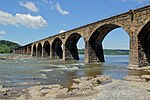Black Gut
Black Gut (known locally as "The Gut") is a 1.4-mile-long (2.3 km) distributary connecting the Susquehanna River to Hartman Run in York County, Pennsylvania in the United States. It was formerly a southeast flowing branch of the Conewago Creek bifurcation where it had once separated Brunner and Lowe's Island from mainland York County in East Manchester Township, joining the Susquehanna at the village of Saginaw. This delta no longer exists due to expansion of the Brunner Island Steam Electric Station. Another branch, known as the River Gut, ran 0.5 miles (0.80 km) from the gut to the Susquehanna. This branch had separated Brunner and Lowe's Island before it was eventually filled in, joining both islands into one.
Excerpt from the Wikipedia article Black Gut (License: CC BY-SA 3.0, Authors).Black Gut
Gut Road / Mason-Dixon Trail, East Manchester Township
Geographical coordinates (GPS) Address Nearby Places Show on map
Geographical coordinates (GPS)
| Latitude | Longitude |
|---|---|
| N 40.074 ° | E -76.676 ° |
Address
Gut Road / Mason-Dixon Trail
Gut Road / Mason-Dixon Trail
17347 East Manchester Township
Pennsylvania, United States
Open on Google Maps










